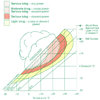Shepherd
Final Approach
That's how long it took to make enough carb ice to kill the engine.
The C-85-8 makes more ice than a refrigerator/freezer. Seriously.
The manual for the C-85-8 says to keep the carb heat on at all times while sitting or taxiing when the conditions will create ice. I know this. I usually practice safe carb heat.
Today, I did my run-up and forgot to leave the carb heat on when I finished.
Add in a "Hold short for landing traffic."
When the tower released me I went out on the runway and started my takeoff roll.
And the engine stopped stone, cold, dead.
Three minutes and twenty-four seconds from run-up to dead engine.
I ended up dragging the plane off the side of the runway.
It restarted on the third pull. <edited for accuracy.
The entire embarrassing episode was caught on camera.
The rest of my 2.2 hour flight today was uneventful.
The C-85-8 makes more ice than a refrigerator/freezer. Seriously.
The manual for the C-85-8 says to keep the carb heat on at all times while sitting or taxiing when the conditions will create ice. I know this. I usually practice safe carb heat.
Today, I did my run-up and forgot to leave the carb heat on when I finished.
Add in a "Hold short for landing traffic."
When the tower released me I went out on the runway and started my takeoff roll.
And the engine stopped stone, cold, dead.
Three minutes and twenty-four seconds from run-up to dead engine.
I ended up dragging the plane off the side of the runway.
It restarted on the third pull. <edited for accuracy.
The entire embarrassing episode was caught on camera.
The rest of my 2.2 hour flight today was uneventful.
Last edited:





